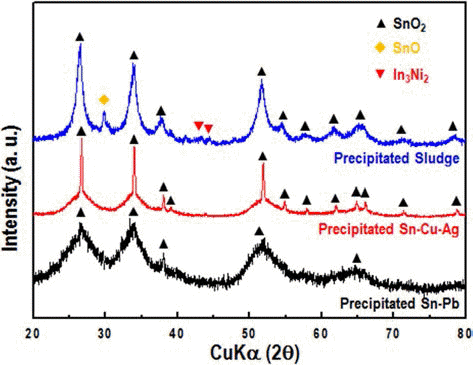Search
- Page Path
- HOME > Search
- [Korean]
- A Study on the Improvement of Storage Stability of Solder Paste Using Multiple size of solder Powder
- Chan-Kyu Lim, Bo-Suk Gyun, Min-Jung Son, Inyoung Kim, Sangsun Yang, Su-Yong Nam
- J Korean Powder Metall Inst. 2017;24(5):395-399. Published online October 1, 2017
- DOI: https://doi.org/10.4150/KPMI.2017.24.5.395

- 1,023 View
- 6 Download
-
 Abstract
Abstract
 PDF
PDF Solder paste is widely used as a conductive adhesive in the electronics industry. In this paper, nano and microsized mixed lead-free solder powder (Sn-Ag-Cu) is used to manufacture solder paste. The purpose of this paper is to improve the storage stability using different types of solvents that are used in fabricating the solder paste. If a solvent of sole acetate is used, the nano sized solder powder and organic acid react and form a Sn-Ag-Cu malonate. These formed malonates create fatty acid soaps. The fatty acid soaps absorb the solvents and while the viscosity of the solder paste rises, the storage stability and reliability decrease. When ethylene glycol, a dihydric alcohol, is used the fatty acid soaps and ethylene glycol react, preventing the further creation of the fatty acid soaps. The prevention of gelation results in an improvement in the solder paste storage ability.
- [Korean]
- Development of Pre-treatment for Tin Recovery from Waste Resources
- Y. H Jin, D. H Jang, H. C Jung, K. W Lee
- J Korean Powder Metall Inst. 2014;21(2):142-146. Published online April 1, 2014
- DOI: https://doi.org/10.4150/KPMI.2014.21.2.142

- 607 View
- 0 Download
- 2 Citations
-
 Abstract
Abstract
 PDF
PDF Fundamental experiences have been studied for development of pre-treatment process of Sn by-products such as solders. Dry and wet separation/recovery processes were considered by the differences of physical properties. The by-products, which are analyzed by solder metal and oxides. The metal and oxide were simply separated by dry ball-milling process for 12 hours, after that recovery metal powder might be reusable as lead or lead-free solders. In terms of wet separation process, samples were dissolved in HNO3 + H2O2 and the precipitation were analyzed by SnO2. Overall efficiency of recovery might be increasing via developing simple pre-treatment process.
-
Citations
Citations to this article as recorded by- Material Flow Analysis for Stable Supply and Demand Management of Tin
Sang Hyun Oh, Hong-Yoon Kang, Yong Woo Hwang, Doo Hwan Kim, Kayoung Shin, Nam Seok Kim
Resources Recycling.2023; 32(4): 18. CrossRef - The Current Status and Securing Strategies of tin Resources for Future Core Industries
Hoseok Jeon, Dohyun Jeong, Yeoni Chu, Seongmin Kim
Journal of the Korean Society of Mineral and Energy Resources Engineers.2022; 59(4): 408. CrossRef
- Material Flow Analysis for Stable Supply and Demand Management of Tin
TOP
 KPMI
KPMI


 First
First Prev
Prev


